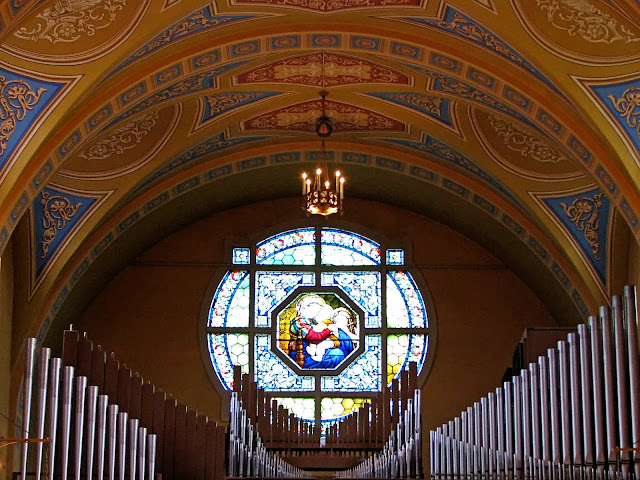Okay. I lied ... which, I suppose in the context of this post, is not a good thing. But there IS something really amazing to see in the thriving metropolis of Perryville, Missouri and we had a chance to check it out during that “what in the heck are we going to do between the wedding ceremony and the reception?” window of time.
When we were wondering how we were going to kill a couple of hours, Mark’s sisters (who had been in town for the entire weekend) told us about a shrine that they were told was worth visiting. I love churches the way I love barns … and lighthouses … and covered bridges. Must be an architectural thing, huh? We’re game; count us in! The five of us headed just a few blocks north.
Saint Mary’s of the Barrens Church is modeled after the chapel at Monte Citorio, the Vincentian motherhouse in Rome. Construction of St. Mary’s began in 1827. The original architecture of the church was Tuscan Renaissance, but renovations altered it to the Romanesque style. The freestanding Angeles bell tower dates to 1980 and matches the 1913 refurbished façade.
When we walked inside, it literally took our breath away. We poked around for several minutes before one of the parishioners offered us a guided tour. I really wish I had written down her name; she was so lovely and her tour informative. Like the churches I saw in Italy, this too was like a mini museum and has its own story to tell.
Above the back wall altar in the large sanctuary is an exact copy of Murillo’s Assumption of the Blessed Virgin Mary, which was imported from Germany.
The sanctuary’s dome painting features the Ascension. This is the spot where hundreds of priests were ordained, many of whom have influenced the early history of the church in America.
On the barrel-vaulted ceiling of the nave is a painting of Saint Vincent de Paul.
He is pictured with angels in heaven and with the men and women of the two communities he founded in the 1600’s: the Congregation of the Mission (the Vincentian priests and brothers) and the Daughters of Charity (the sisters community).
In the back of the church is the Rose Window, Raphael’s Madonna of the Chair, which was added in the 1913-1920 renovations. The present organ was bought used, rebuilt, and placed in 1972. It has 11.5 ranks and over 700 hundred pipes, 122 of which are from the original tracker organ formerly located in the sanctuary choir loft.
The church also has eight side chapels with amazing sculptures and paintings which commemorate various Catholic devotions and saints. The Little Flower Chapel,
the Saint Louise de Marillac Chapel, the Saint Joseph Chapel, the Sacred Heart Chapel, the Passion Chapel, the Saint Vincent de Paul Chapel, and the Saint John Gabriel Perboyre Chapel.
The most breathtaking chapel, however, is the National Shrine to Our Lady of the Miraculous Medal. For those of you not up to speed on your Catholicism, a Marian apparition is an event in which the Blessed Virgin Mary is believed to have supernaturally appeared to one or more people. The vision of Our Lady of the Miraculous Medal is said to have appeared to Saint Catherine Labouré in 1830 in the convent of Rue du Bac, Paris. She reported that one night in the chapel, Mary appeared to her and asked that a medallion be made to a design that she dictated. She added that, “All who wear this medal will receive great graces.” After spending two years examining St. Catherine’s claims, her priest eventually took the information to his archbishop. The medal eventually produced became known as the Miraculous Medal.
The shrine was added to the church in 1929-1930 by promoters of the Association of the Miraculous Medal and replaced an older shrine of Mary which had originally been built. The chapel ceiling has a copy of a painting found at the Mother House of the Daughters of Charity in Paris. The top of the painting shows Mary as she appears on the medal and below Saint Catherine distributing medals to the people of Paris.
Stained glass windows above the altar depict the first and second apparitions of Mary and Saint Catherine, and the third is portrayed in a painting where Mary reveals the design of the medal.
The statue above the altar and the words in the archway, “O Mary, conceived without sin, pray for us who have recourse to Thee,” detail the front of the medal. The back of the medal is depicted in the base of the altar with the large “M” surmounted by a cross, the twelve stars symbolizing the apostles, who are the foundation stones of the Church, and the stars of heaven (Mary is Queen of Heaven). We each were offered a Miraculous Medal and I readily accepted. It is said to provide extraordinary graces for those who wear it and I need all the help I can get!
The remaining sites of the Saint Mary’s of the Barrens Historic District, including a grotto and the Vincentian Community Cemetery, were located outside. Unfortunately, it had started to rain and we were out of time. I don’t know if or when I’ll ever be back in Perryville, Missouri, but this unexpected pleasure during our stay there was absolutely stunning and a most welcomed discovery. If you ever find yourself in the area, it definitely is well worth the visit!
National Shrine of Our Lady of the Miraculous Medal
1811 West Saint Joseph Street
Perryville, Missouri













1 comment:
You should have picked me up a miraculous medal too. Just like you, I'll take all the help I can get:)
Post a Comment